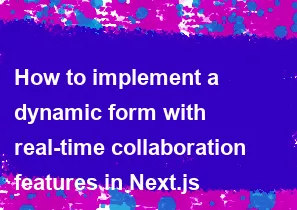How to implement a dynamic form with real-time collaboration features in Next.js

Implementing a dynamic form with real-time collaboration features in Next.js involves several steps. Real-time collaboration typically involves using WebSocket connections to synchronize changes across clients. Here's a basic outline of how you could implement this:
Set Up Next.js Project: If you haven't already, create a new Next.js project.
Create Form Component: Create a React component for your dynamic form. You can use libraries like Formik or React Hook Form to manage form state.
Integrate Real-Time Collaboration:
- Choose a real-time collaboration framework. Socket.io is a popular choice for WebSocket communication.
- Set up a WebSocket server. You can use libraries like Socket.io for this purpose. You can create a new server or integrate it with your existing Next.js server.
- Implement functionality to broadcast form changes to all connected clients. When a user makes a change to the form, send the updated form data over the WebSocket connection to the server, which then broadcasts it to all connected clients.
Handle Form Updates: Update your form component to listen for changes from the WebSocket server. When the form data is received from the server, update the form state accordingly to reflect the changes.
Authentication and Authorization: Implement authentication and authorization to ensure that users can only edit the parts of the form that they have permission to access.
Testing: Test your application to ensure that real-time collaboration features work as expected. Simulate multiple users making changes to the form simultaneously to verify synchronization.
Here's a simplified example of how you might set up the real-time collaboration functionality using Socket.io:
javascript// server.js
const http = require('http');
const { Server } = require('socket.io');
const server = http.createServer();
const io = new Server(server);
io.on('connection', (socket) => {
console.log('A user connected');
socket.on('formUpdate', (formData) => {
// Broadcast the updated form data to all connected clients except the sender
socket.broadcast.emit('formUpdate', formData);
});
socket.on('disconnect', () => {
console.log('A user disconnected');
});
});
server.listen(3001, () => {
console.log('Socket.io server listening on *:3001');
});
In your Next.js component:
javascriptimport React, { useState, useEffect } from 'react';
import io from 'socket.io-client';
const socket = io('http://localhost:3001');
const DynamicForm = () => {
const [formData, setFormData] = useState({ /* Initial form data */ });
useEffect(() => {
socket.on('formUpdate', (updatedFormData) => {
setFormData(updatedFormData);
});
return () => {
socket.off('formUpdate');
};
}, []);
const handleFormChange = (e) => {
const { name, value } = e.target;
const updatedData = { ...formData, [name]: value };
setFormData(updatedData);
socket.emit('formUpdate', updatedData);
};
return (
<form>
{/* Render form fields based on formData state */}
<input type="text" name="field1" value={formData.field1} onChange={handleFormChange} />
<input type="text" name="field2" value={formData.field2} onChange={handleFormChange} />
{/* Add more form fields as needed */}
</form>
);
};
export default DynamicForm;
This is a basic example to get you started. Depending on your requirements, you may need to add more features like error handling, validation, and security measures. Additionally, you might want to explore more advanced real-time collaboration frameworks or libraries tailored for specific use cases.
-
Popular Post
- How to optimize for Google's About This Result feature for local businesses
- How to implement multi-language support in an Express.js application
- How to handle and optimize for changes in mobile search behavior
- How to handle CORS in a Node.js application
- How to use Vue.js with a UI framework (e.g., Vuetify, Element UI)
- How to configure Laravel Telescope for monitoring and profiling API requests
- How to create a command-line tool using the Commander.js library in Node.js
- How to implement code splitting in a React.js application
- How to use the AWS SDK for Node.js to interact with various AWS services
- How to use the Node.js Stream API for efficient data processing
- How to implement a cookie parser middleware in Node.js
- How to implement WebSockets for real-time communication in React
-
Latest Post
- How to implement a dynamic form with dynamic field styling based on user input in Next.js
- How to create a custom hook for handling user interactions with the browser's device motion in Next.js
- How to create a custom hook for handling user interactions with the browser's battery status in Next.js
- How to implement a dynamic form with dynamic field visibility based on user input in Next.js
- How to implement a dynamic form with real-time collaboration features in Next.js
- How to create a custom hook for handling user interactions with the browser's media devices in Next.js
- How to use the useSWRInfinite hook for paginating data with a custom loading indicator in Next.js
- How to create a custom hook for handling user interactions with the browser's network status in Next.js
- How to create a custom hook for handling user interactions with the browser's location in Next.js
- How to implement a dynamic form with multi-language support in Next.js
- How to create a custom hook for handling user interactions with the browser's ambient light sensor in Next.js
- How to use the useHover hook for creating interactive image zoom effects in Next.js